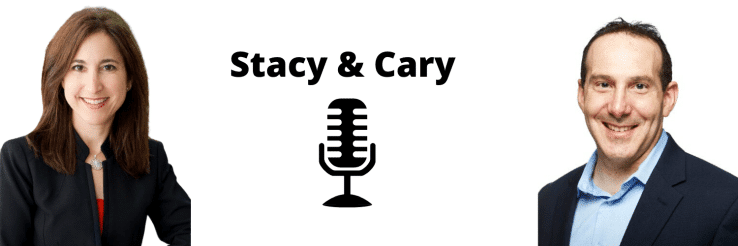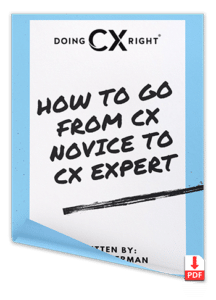
Let’s Talk CX – Interview Series
My passionate customer success friend, Cary Munk, asked to interview me for a special CX project he’s working on. Of course, when there’s an opportunity to talk about customer experience, employee engagement, and building a best-in-class company culture, I’m all in.
While this interview video is not available yet to view, I’m sharing some of our conversations as a preview of several CX talks to come. I am confident you’ll learn something from the series. If there’s a specific CX topic you want to hear more about, please let me know as the “voice of my readers” matters a lot.
Customer Experience (CX) Interview:

CARY: Today, I’m delighted to interview Stacy Sherman, who is the head of CX, Employee Engagement, and Culture Transformation at Schindler Elevator Corporation, USA division. (Formerly at Verizon.) Stacy’s is dedicated to HUMANIZING business and challenging the status quo to maximize satisfaction globally. Stacy is a featured guest on CX podcasts, contributing writer to Forbes and other publications, and also a writer of a popular blog, DoingCXRight®. Glad to have Stacy, who humanizes the workplace and believes that brands who create a memorable experience for customers are the ones that win in the long run. On a personal note, Stacy continues to amaze me with her thoughtfulness and knowledge and is someone who I continuously learn from. Stacy, thank you for joining us.
STACY: Thank you for the great introduction. I’m glad to be here.
CARY: Stacy, so who are you when you’re not at your day job? What are your personal interests?
STACY: My most favorite role in life is being a Mom of two kids. Other than that, I have a full-time job, and when I’m not at work, I’m still CX focused. It may sound cliché, but I really walk the talk as I’m Doing CX Right at night and weekends. In general, I am fascinated about the heart and science of CX and continue my studies to deliver great experiences in impactful ways. When I’m not at work, I love to travel the world, notice it, write about it, speak about it. It’s just part of me. You can read a great example of this from my vacation in Anguilla. I interviewed staff members who created Wow Moments for me and other customers. I was intrigued by how much they owned the customer experience even if it wasn’t their direct department. From the interviews, I noticed they all had one thing in common, which is a love of their job. It proves an important point that happy employees fuel happy customers all around the globe. Anyway, to the original question, I’m reading about CX, listening to podcasts, and Ted talks in my spare time. What I’m trying to say is that my hobbies all tie back to CX since it’s my passion.
CARY: That’s amazing. So, you’re the same person at work and at home.
STACY: Yes. You have to be because if you’re going to do what I call humanize business, you have to be human and real all the time. It’s not scripted.
CARY: That’s true. Not everyone can say that. It makes you unique. Let’s start from the beginning. What was your background and how did you pivot into CX?
STACY: It’s an interesting story and I imagine everybody you talk to will have some fascinating background. My career began in sales and marketing at AT&T after college. In a way you can say that is a CX job as it’s customer focused. Back then, the word CX didn’t exist but the basic principles of delighting customers did. I had to meet customer needs and expectations in those roles or I would never have made my sales objectives. The true practice of CX and methodologies came when I was at Verizon. I remember the day my boss threw me a ball. He said that my responsibilities are expanding and I’ll be leading Customer Experience (CX) and Voice of Customer (VOC) initiatives. I had no idea what that meant and later learned that he didn’t either. We both intuitively knew that customer experience would grow in importance and that my career depended on my figuring it out. That’s exactly what I did by learning all about getting customer feedback, measuring customer satisfaction, using insight to drive improvements and so much more. The long answer to your question, Cary, is I literally fell into the CX field, and never stopped since I “caught the ball.”
CARY: You really grabbed onto that ball.
STACY: Yes, I did. I had to run forward and sideways, and figure it out with minimal support. While I felt uncertain at the time, I’m grateful that my old boss trusted me to learn and excel as CX as it quickly became a booming field, and experts are in high demand. Every company needs to focus on customer experience to gain a competitive edge. My one advice is if you want to differentiate your brand, start with your employees first. They can make or break a company’s reputation.
CARY: I know that you have worked at companies that provide omnichannel experiences. How does CX apply?
STACY: Most of my jobs included omnichannel (online and offline) experience. It’s an important topic because for brands to succeed, they must make it really easy for customers to learn about products and services, buy without difficulties and get help when they need it. When working at Verizon, the team and I deployed “Buy Online, Pick Up At Store” on the eCommerce website. The launch was a success however, through listening to customer feedback, we learned that there were improvement opportunities. When customers went to their local retail store, they had to wait on a line to pick-up their purchased device and became increasingly frustrated about the wait time. By leveraging “voice of customer” (VOC) data, we were able to identify the challenges and improve the pickup experience. For example, we established separate lines for people visiting the store based on whether they already paid and picking up an order versus people coming to shop and purchase in person. We were also able to provide personalized service to those who already bought since we knew who they were in advance of arrival. My point is that buying online and picking up in-store became its own experience. Companies who operate and serve customers in digital and non-digital ways need to account for the entire customer journey. It must be a holistic approach and seamless to customers as that’s when they will likely purchase again and tell others to buy too.
CARY: Your story makes a lot of sense. You were listening to customers and getting their feedback to make positive changes to enhance customer experiences.
STACY: Correct. If we had not asked customers about their purchase and pick up experiences, we might not have known about their pain points to improve them. So, I can’t emphasize it enough. Ask customers about their level of satisfaction, sentiments, and level of effort when interacting with your brand. Get feedback and then do something with it. That’s when the magic happens.
CARY: So true. You have worked at a variety of companies and industries; from consumer brands to telecom and mobility, what would be one takeaway that CX practitioners can apply no matter where they work?
STACY: I have so much to say, but I’ll sum it up. Regardless of industry, start with your greatest assets which are your employees. Actively listen, empathize, and provide great experiences for them because the more employees are happy, the more your customers will be too. CX and EX go hand in hand.
CARY: Sounds like you are referring to creating a customer-centric culture.
STACY: Yes. The best leaders and brands focus on employee satisfaction AT ALL LEVELS of the organization so that everyone feels empowered and owns CX. Culture starts at the top with an executive champion, yet it also requires a bottoms up approach. I recommend deploying a formal education program within companies. The more that internal teams know about why and how to deliver customer excellence, the greater chance they will be change agents and transform the business. CX trained employees will more often do the right thing for customers, even when their boss isn’t looking. Choosing the right CX program is essential as there are a lot out there, but not all are reputable. Learn about my class experience and recommended universities. I’m happy to share details of the course and what I learned. Likewise, you’ll find valuable resources and articles on my blog to gain practical tips to apply now whereever you work.
CARY: You speak about having buy-in from the top, creating a culture with employee recognition and empathy, and differentiating brands through CX. I’ve been thinking about how CX has been around for many years. Why do you think it’s such a hot topic now more than ever?
STACY: In the past, companies could compete on price alone, but now, in a hyper-competitive environment, that’s changed. Think about Starbucks for example. There are many places to get a cup of coffee. I shop at Starbucks NOT because I enjoy paying triple the cost versus my local .99 cent coffee place. I am a loyal Starbucks customer because of the experience they provide. From the moment I walk into the store, people greet me by name. Employees intentionally make an effort to know their reoccurring customers. I also appreciate how they handle mistakes when they happen. Employees fix issues with no questions asked. They’ll even go up and beyond to ensure I like something I’m ordering for the first time by providing me a taste before purchasing it. I’m noticing more local cafes are doing this, and I love it. Brands are also getting more sophisticated with their apps and saving customers time before entering the store. That’s where user experience (UX) becomes an essential factor in choosing which brands to buy from. I can go on and on about this. I’ll sum up by saying experiences matter especially when competitive companies are relatively the same price. Read my Forbes article about what coffee shops can teach brands about customer experience.
CARY: I’ve had a similar Starbucks experience. From the moment I walk in and smell the aroma to when I walk out with a cup of cappuccino.
STACY: The physical experience is a part of the customer journey. People immediately judge brands from their first moment when walking into a Doctor’s office, restaurant, etc. We could talk for hours about first impressions and onboarding experiences. Perhaps in the future.
CARY: So true. Let’s end on inspiring our audience with something positive that we we’ll look back upon as we are going through an uncertain and unprecedented time. One of my takeaways is humorous. Yesterday, I opened the door to my bedroom and there’s a woman on the floor doing yoga… with a video screen of twenty other people doing yoga. It looked like a yoga studio with a mat, blocks, candles and it took me a few seconds to realize… oh, that’s my girlfriend. And on a personal note, we had planned on moving in together later this year when my daughter starts college. This experience has brought us closer and enhanced our relationship. Stacy, what’s your rainbow? What are you going to remember when you look back?
STACY: I love this question. I did something that I may never have done if it hadn’t been for Covid19. When the pandemic first started, I contacted about thirty people around the world to learn how they are staying content and productive while socially distancing. Every story I heard was better than the next. One guy in Italy was learning how to bake all kinds of homemade bread. Another guy was creating YouTube lessons with his son to teach children how to play basketball. I captured all the different stories and created an article from the lessons shared. It quickly went viral globally. It’s one of my most favorites because it inspired others at a time when people feel like they’re going against gravity. So to your question about “what’s my rainbow,” my answer is it is all the amazing connections and conversations from my article interviews. Their collective answers are what I’ll remember most.
CARY: That’s inspiring and a good place to wrap-up. Thank you for finding time to chat. For anyone reading this, where can they find you?
Stacy: My website is DOINGCXRIGHT. You’ll see my contact information, articles, podcasts, and customer experience best practices. Thank you for the time together today, Cary. Bottom line: I’m on a mission to help connect people and inspire great authentic experiences to increase satisfaction. I hope people will join me on the journey. Together, we can make a difference!
CARY: Thank you Stacy. Have a great day.
STACY: You too.
If you want to know more about Cary Munk, connect with him on LinkedIn. And, if you want more information or CX coaching from me, Stacy Sherman, please email me at Stacy@DoingCXRight.com. I’m happy to help the community because together, we can create better experiences for all.
Wishing you much success in the world of CX.






